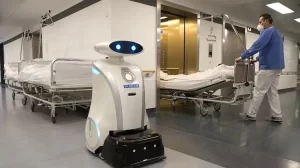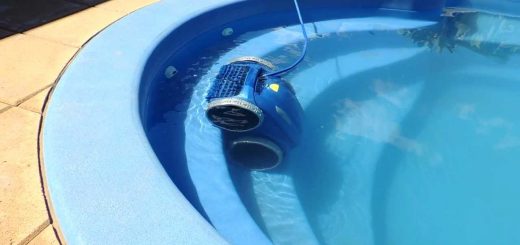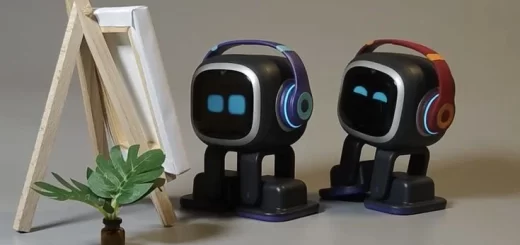Hospital cleaning robots importance, drawbacks and How are robots used in hospitals?
Hospital cleaning robots use ultraviolet (UV) light to zap germs on surfaces. UV light disrupts the DNA of bacteria and viruses, making them unable to reproduce. These robots can work around the clock, helping to keep hospitals clean 24/7.
Hospital cleaning robots
Some hospital cleaning robots can navigate autonomously – that means they can move around on their own without bumping into things. They can be programmed to clean specific areas efficiently. These robots use ultraviolet (UV) light or other disinfectants to kill germs and bacteria on floors, surfaces, and in the air.
Some robots use cameras and sensors to avoid obstacles and map their surroundings to ensure they clean every nook and cranny. these robots are a big help in the fight against hospital-acquired infections.
Hospital cleaning robots are a fascinating new technology that’s helping to keep hospitals cleaner and safer for everyone. These robots don’t bump blindly around the halls. They use lasers or cameras to map their surroundings and clean them efficiently. Hospitals have a lot of floor space, and these tireless bots can clean for hours on a single charge.
Some hospital cleaning robots use ultraviolet light to kill germs that mop and rags might miss. They help human cleaners focus on higher-risk areas, robots allow human staff to focus on cleaning patient rooms and other high-risk areas.
Some hospital robots can disinfect a room in just minutes, which is much faster than traditional cleaning methods. Some hospital cleaning robots are designed to be cute or non-threatening, which can help put patients at ease. Robots are becoming valuable tools in the fight against hospital-acquired infections.
Advantages of Hospital cleaning robots
Robots can use UV light or other disinfectants to reach and neutralize germs on surfaces that humans might miss, leading to a cleaner environment. Robots can tirelessly clean rooms quickly and consistently, freeing up staff for more complex tasks.
Robots can handle hazardous cleaning chemicals, reducing exposure risks for staff. By limiting human contact with contaminated surfaces, Robots can help lower the spread of hospital-acquired infections.
Hospital cleaning robots can eliminate pathogens more effectively than traditional methods, potentially reducing hospital-acquired infections (HAIs). They can reach areas that might be difficult for humans to reach, ensuring a more thorough clean. Robots can clean rooms much faster than humans, freeing up staff time for other tasks.
Robots can operate continuously without breaks, Some robots can track cleaning patterns and identify areas that require extra attention. Robots can disinfect rooms quickly and tirelessly, freeing up staff for other tasks.
By limiting human contact with contaminated surfaces, robots can help to reduce the spread of hospital-acquired infections (HAIs). Unlike humans, robots don’t get tired or take breaks, so they can maintain a consistent level of cleaning throughout the day.
Disadvantages of Hospital cleaning robots
Robots may not be able to clean all areas effectively, particularly complex spaces or those requiring delicate handling. Overdependence on robots could lead to complacency in other aspects of infection control. Robots can malfunction or break down, requiring repairs or downtime.
As robots become more prevalent, some cleaning staff positions might be reduced. Overdependence on robots could lead to neglect of traditional cleaning methods or human oversight. Malfunctioning robots could disrupt cleaning schedules and require technical expertise to fix. If a robot breaks down, it could disrupt the cleaning schedule and potentially compromise hygiene standards.
Robotic hospital cleaners offer significant advantages in terms of disinfection efficacy and efficiency. However, their high cost, limited cleaning capabilities, and potential for job displacement necessitate careful consideration before implementation. Purchasing and maintaining robots can be expensive, especially for smaller hospitals.
Current robots may not be able to handle all cleaning tasks, such as mopping floors or cleaning complex equipment. The use of robots for cleaning could lead to job losses for some hospital staff. Robots may not be able to clean everything in a room, such as complex equipment or heavily soiled areas. They may also struggle to navigate around obstacles.
Saul UV disinfection robot review, use, advantages, and disadvantages
Top trends on Saul UV disinfection robot and What can Saul do?
Laboratory robotics uses, advantages, and disadvantages
Computers in Medicine uses, advantages and disadvantages
Robotic surgery cons, pros, uses and How does robotic surgery work?
Artificial intelligence in medical field advantages & how AI medical diagnosis changes medicine
Surgical robots types, advantages, disadvantages, How is robotic surgery different from traditional
You can follow Science Online on Youtube from this link: Science online
You can download Science online application on Google Play from this link: Science online Apps on Google Play




